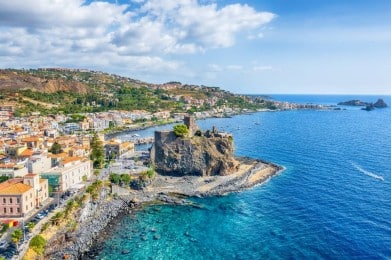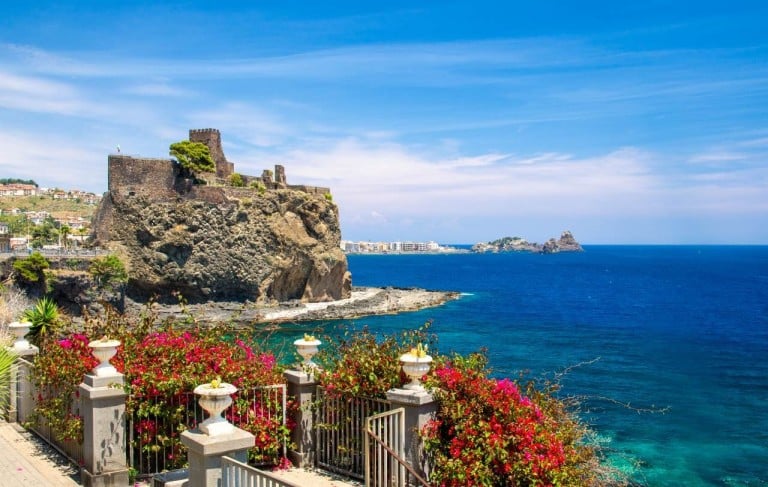Perched on a cliff of black lava stone overlooking the Ionian Sea, the Norman Castle of Aci Castello stands like an eternal sentinel, an unmistakable symbol of this Sicilian village that takes its name from the very fortress. Its irregular shape and spectacular location give it the appearance of a stone ship stranded between sky and sea, immersed in a breathtaking landscape where legend and reality have been intertwined for centuries.
Ancient origins and strategic role
The castle’s historical roots go back well before Norman times. According to sources, a first fortification – Castrum Jacis – was erected in Roman times, perhaps as early as 38 AD, at a strategic point that allowed control of the stretch of sea between Catania and the Strait of Messina. During the Byzantine period, in the 6th or 7th century, a real castle was built, later destroyed by the Arabs in 902. The present structure was built by the Normans between 1071 and 1081, during their conquest of Sicily, using lava stone boulders from Mount Etna.
A place of power, worship and resistance
Over the centuries, the castle was at the center of disputes between dynasties, bishops, kings and rebels. Significant episodes include the handover of the relics of St. Agatha in 1126 to the bishops of Catania, the naval battle known as the checkmate of Ognina against the Angevins in 1354, and the 1396 siege by Martin the Younger, who conquered it and made it his home with Bianca of Navarre. The castle experienced a period of splendor with receptions and celebrations, before passing through several hands-from the monarchy to feudal lords, to the Demanio Comunale in the 19th century.
Architecture and access
The castle is naturally inaccessible on three sides: it stands on a lava outcrop that was once separated from the mainland by an arm of the sea, later filled in by a lava flow in 1169. Today the fortress is accessed from the west, via a flight of steps and a masonry bridge that replaced the old wooden drawbridge. Inside, evocative rooms develop, including the Byzantine chapel, a central courtyard, vaulted halls, and a panoramic terrace offering extraordinary views of the Faraglioni and the Riviera dei Ciclopi.
The Civic Museum and thematic sections
Since 1985, the castle has housed the Aci Castello Civic Museum, divided into three main sections:
-Mineralogy: a collection of minerals from around the world and from the volcanic areas of Etna, documenting the geological richness of the region.
-Paleontology: fossil finds that tell the story of the evolution of life in Sicily, with specimens also from marine deposits.
–Archeology: materials found in the waters off the coast, evidence of continuous human habitation since Greek and Roman times.
The museum’s showcases display amphorae, ceramics, tools and the remains of boats, which help the visitor imagine the intense commercial and maritime traffic that has affected this area over the centuries.
The Botanical Cactus Garden
Another jewel of the castle is the Botanical Garden, located in the main courtyard. It is a unique green area that takes advantage of the local microclimate to allow numerous succulent cacti plants from Bolivia, Mexico, Morocco, Madagascar, and Peru to thrive. The garden not only enriches the visitor experience, but also provides an example of environmental enhancement and botanical exoticism.
A year-round cultural center
The castle is not just a static monument, but a living space that hosts exhibitions, events, plays and concerts throughout the year. In particular, the Norman Hall, named after the painter Jean Calogero, hosts artistic and cultural events that make the visitor’s experience even more vibrant. During the summer, the re-enactment of Martin the Younger’s assault draws hundreds of spectators for a show that combines history and outdoor theater.
An identity symbol for the community
The Norman Castle of Aci Castello is not only an architectural and historical heritage: it is the beating heart of the village, witness to centuries of life, wars, loves and legends. From the mythical story of Aci and Galatea, to the novella Le stoffe del Castello di Trezza by Giovanni Verga, to the folk tales of prisoners and revenge, this castle is a living part of the identity of the place. Visiting it is an exciting journey between stone and sea, where every corner tells a story.


